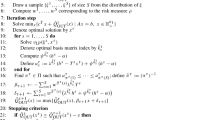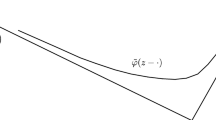Abstract
In the setting of stochastic recourse programs, we consider the problem of minimizing the probability of total costs exceeding a certain threshold value. The problem is referred to as the minimum risk problem and is posed in order to obtain a more adequate description of risk aversion than that of the accustomed expected value problem. We establish continuity properties of the recourse function as a function of the first-stage decision, as well as of the underlying probability distribution of random parameters. This leads to stability results for the optimal solution of the minimum risk problem when the underlying probability distribution is subjected to perturbations. Furthermore, an algorithm for the minimum risk problem is elaborated and we present results of some preliminary computational experiments.
Similar content being viewed by others
References
S. Ahmed, M. Tawarmalani, and N.V. Sahinidis, “A finite branch and bound algorithm for two-stage stochastic integer programs,” Submitted for publication. Available at http://www.isye.gatech.edu/∼sahmed, 2000.
Z. Artstein and R.J.-B. Wets, “Stability results for stochastic programs and sensors, allowing for discontinuous objective functions,” SIAM Journal on Optimization, vol. 4, pp. 537-550, 1994.
B. Bank, J. Guddat, D. Klatte, B. Kummer, and K. Tammer, Non-Linear Parametric Optimization, Akademie-Verlag: Berlin, 1982.
B. Bereanu, “Minimum risk criterion in stochastic optimization,” Economic Computation and Economic Cybernetics Studies and Research, vol. 2, pp. 31-39, 1981.
R.N. Bhattacharya and R. Ranga Rao, “Normal Approximation and Assymptotic Expansions,” John Wiley: New York, 1976.
P. Billingsley, Convergence of Probability Measures, Wiley: New York, 1968.
J.R. Birge and F.V. Louveaux, Introduction to Stochastic Programming, Springer-Verlag: New York, 1997.
C.C. Carøe and R. Schultz, “Dual decomposition in stochastic integer programming,” Operations Research Letters, vol. 24, pp. 37-45, 1999.
J. Dupačová, “Stochastic programming with incomplete information: A survey of results on postoptimization and sensitivity analysis,” Optimization, vol. 18, pp. 507-532, 1987.
W.K. Klein Haneveld and M.H. van der Vlerk, “On the expected value function of a simple integer recourse problem with random technology matrix,” Journal of Computational and Applied Mathematics, vol. 56, pp. 45-53, 1994.
R. Hemmecke and R. Schultz, “Decomposition of test sets in stochastic integer programming,” Mathematical Programming (to appear).
J.L. Higle and S. Sen, “Stochastic decomposition: An algorithm for two-stage linear programs with recourse,” Mathematics of Operations Research, vol. 16, pp. 650-669, 1991.
J. Hoffmann-Jørgensen, Probability with a View Toward Statistics, vol. 1, Chapman &; Hall: New York, 1994.
P. Kall, “On approximations and stability in stochastic programming,” in Parametric Optimization and Related Topics, J. Guddat, H.Th. Jongen, B. Kummer, and F. Nožiøka (Eds.), Akademie Verlag: Berlin, 1987, pp. 387-407.
P. Kall and S.W. Wallace, Stochastic Programming, John Wiley: Chichester, UK, 1994.
A.H.G. Rinooy Kan and L. Stougie, “Stochastic integer programming,” in NumericalTechniques for Stochastic Optimization, Y. Ermoliev and R.J.-B. Wets (Eds.), Springer-Verlag: Berlin, 1988, pp. 201-213.
A.I. Kibzun and Y.S. Kan, Stochastic Programming Problems with Probability and Quantile Functions, John Wiley: Chichester, UK, 1996.
D. Klatte, “A note on quantitative stability results in nonlinear optimization,” in Proceedings of the 19. Jahrestagung Mathematische Optimierung, K. Lommatzsch (Ed.), Seminarbericht Nr. 90, Sektion Mathematik, Humboldt-Universität Berlin, 1987, pp. 77-86.
A. Løkketangen and D.L. Woodruff, “Progressive hedging and tabu search applied to mixed integer (0,1) multistage stochastic programming,” Journal of Heuristics, vol. 2, pp. 111-128, 1996.
F.V. Louveaux and M.H. van der Vlerk, “Stochastic programming with simple integer recourse,” Mathematical Programming, vol. 61, pp. 301-325, 1993.
A. Prékopa, Stochastic Programming, Kluwer Academic Publishers: Dordrecht, Netherlands, 1995.
S.T. Rachev and W. Römisch, “Quantitative stability in stochastic programming: The method of probability metrics,” Preprint 2000–22, Humboldt-Universität zu Berlin, Institut für Mathematik, 2000.
E. Raik, “Qualitative research into the stochastic nonlinear programming problems,” Eesti NSV Teaduste Akademia Toimetised (News of the Estonian Academy of Sciences) Füüs Mat., vol. 20, pp. 8-14, 1971 (In Russian).
E. Raik, “On the stochastic programming problem with the probability and quantile functionals,” Eesti NSV Teaduste Akademia Toimetised (Newsof the Estonian Academy of Sciences) Füüs Mat., vol. 21, pp. 142-148, 1972 (In Russian).
S.M. Robinson, “Local epi-continuity and local optimization,” Mathematical Programming, vol. 37, pp. 208-222, 1987.
S.M. Robinson and R.J.-B. Wets, “Stability in two-stage stochastic programming,” SIAM Journal on Control and Optimization, vol. 25, pp. 1409-1416, 1987.
W. Römisch and R. Schultz, “Distribution sensitivity in stochastic programming,” Mathematical Programming, vol. 50, pp. 197-226, 1991.
W. Römisch and R. Schultz, “Stability analysis for stochastic programs,” Annals of Operations Research, vol. 30, pp. 241-266, 1991.
W. Römisch and R. Schultz, “Stability of solutions for stochastic programs with complete recourse, Mathematics of Operations Research, vol. 18, pp. 590-609, 1993.
A. Ruszczyński, “A regularized decomposition method for minimizing a sum of polyhedral functions,” Mathematical Programming, vol. 35, pp. 309-333, 1986.
R. Schultz, “Continuity and stability in two-stage stochastic integer programming,” in Stochastic Optimization, Numerical Methods and Technical Applications, volume 379 of Lecture Notes in Economics and Mathematical Systems, K. Marti (Ed.), Springer-Verlag: Berlin, 1992, pp. 81-92.
R. Schultz, “Continuity properties of expectation functions in stochastic integer programming,” Mathematics of Operations Research, vol. 18, pp. 578-589, 1993.
R. Schultz, “On structure and stability in stochastic programs with random technology matrix and complete integer recourse,” Mathematical Programming, vol. 70, pp. 73-89, 1995.
R. Schultz, “Rates of convergence in stochastic programs with complete integer recourse,” SIAM Journal on Optimization, vol. 6, pp. 1138-1152, 1996.
R. Schultz, L. Stougie, and M.H. van der Vlerk, “Solving stochastic programs with integer recourse by enumeration: A framework using Grübner basis reductions,” Mathematical Programming, vol. 83, pp. 229-252, 1998.
A. Shapiro, “Quantitative stability instochastic programming,” Mathematical Programming, vol. 67, pp. 99-108, 1994.
L. Stougie, Design and Analysis of Algorithms for Stochastic Integer Programming, CWI Tract, 37. Center for Mathematics and Computer Science: Amsterdam, 1987.
R.M. Van Slyke and R.J.-B. Wets, “L-shaped linear programs with applications to optimal control and stochastic linear programming,” SIAM Journal of Applied Mathematics, vol. 17, pp. 638-663, 1969.
R.J.-B. Wets, “Stochastic programs with fixed recourse: The equivalent deterministic program,” SIAM Review, vol. 16, pp. 309-9339, 1974.
Author information
Authors and Affiliations
Corresponding author
Rights and permissions
About this article
Cite this article
Riis, M., Schultz, R. Applying the Minimum Risk Criterion in Stochastic Recourse Programs. Computational Optimization and Applications 24, 267–287 (2003). https://doi.org/10.1023/A:1021862109131
Issue Date:
DOI: https://doi.org/10.1023/A:1021862109131




